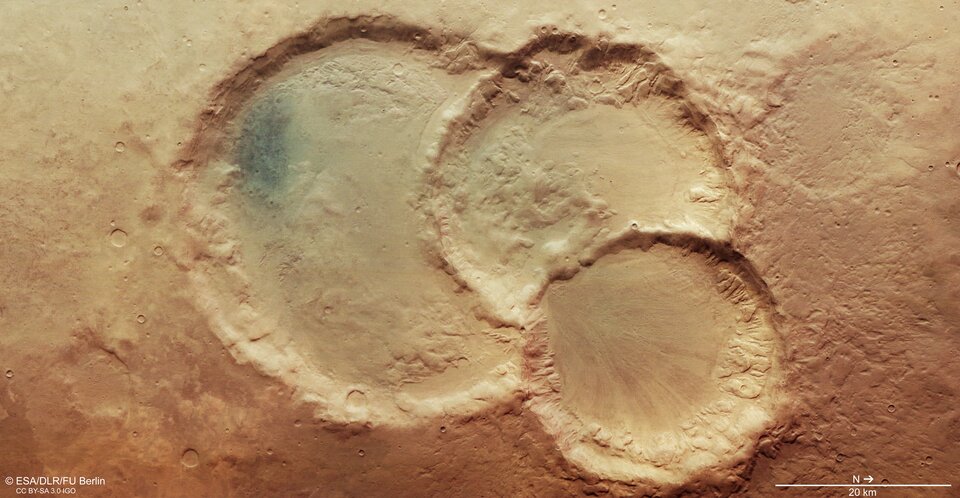An ancient crater triplet on Mars
Mars is covered in intriguing scars – some of the most prominent being impact craters. A particularly unusual example is shown in this new image from ESA’s Mars Express: an ancient triplet comprising not one but three overlapping craters.
The crater triplet is located in an especially old part of Mars’ southern hemisphere known as Noachis Terra. This region was heavily cratered during the Noachian era, an ancient time about four billion years ago in Mars’ history in which huge numbers of asteroids and comets flew inwards to crash into the planet's surface. Some of the features created by these collisions remain intact on Mars today and, as they formed during the very earliest days of the Solar System, are of particular interest to scientists seeking to know more about our planetary neighbour and its past.

Signs of chaotic Noachian processes and events are seen especially clearly in Mars’ southern highlands, which are peppered with old, time-worn craters. ESA’s Mars Express has imaged many craters in this region, from the severely eroded Greeley Crater, named after the American geologist Ronald Greeley, to the dune-patterned Neukum Crater, named after one of the founders of the Mars Express mission (and the former Principal Investigator of the spacecraft’s High Resolution Stereo Camera (HRSC), the camera responsible for this new image).
This image shows a triple crater found just east of a better-known feature named Le Verrier Crater, which spans nearly 140 km across. By contrast, the three depressions seen here are somewhat smaller; the largest measures 45 km across, and the smallest 28 km.

How would such a crater triplet form? One possible explanation – and that thought to be most likely – is that the impactor broke into three before hitting the ground, forming a crater trio upon impact. Not all ‘multiple impactors’ leave such clear and neat features in their wake, with many instead showing elongated troughs, non-circular hollows lying closely side-by-side, or only partially overlapping basins. Another explanation could be coincidence: at different points in time, three separate impactors could have hit Mars’ surface in this location, creating a neat superposition of craters completely by chance.
Interestingly, if the impactor did indeed fragment and break apart, this may imply that the atmosphere of Noachian Mars was far denser – and harder to penetrate – than it is now. This points towards an early Mars that was far warmer and wetter than the cold, arid world we see today. Observations from numerous missions are supporting this view and returning evidence that water once flowed across the Red Planet in large amounts, revealing features such as old river valley networks and large lake basins thought to have formed in the Noachian period.

Like many of the ancient and eroded craters in Mars’ southern highlands, these three craters have flattened rims, shallow floors, and have been filled with sediment in the four billion years since their formation. There is also evidence of ice here – the smallest crater has marks that are typically created as ice and debris creep across a surface, similar to how mixed rock-and-ice glaciers or debris-covered ice glaciers move in alpine regions of Earth.
This frame may once have contained other craters, as indicated by the round patches of sunken surface to the top right and bottom left. In fact, despite the cratered nature of Noachis Terra, the environment around this triplet is surprisingly smooth for such ancient terrain. Only a handful of small surrounding craters appear to have clear, sharply defined rims and bowls, indicating that they are relatively young and have not yet begun to erode in earnest. Overall, it seems that older craters in this area have ‘melted down’ into the surface – a phenomenon that is, again, due to ice.
As ice just under the surface of Mars flows and melts over many millions of years, the soil becomes softer. This soft, ice-rich soil subsides more quickly and fills up indentations and depressions more readily, contributing to the smooth appearance of this part of Noachis Terra. This suggests that there must have been a large amount of water present on Mars, at least during the Noachian period, capable of producing a glacier-like flow of abundant ice.

Understanding the history of Mars, and mapping the features covering the planet’s surface in detail, is a key objective of Mars Express. The spacecraft has been exploring the Red Planet since its launch in 2003, and is gearing up to collaborate with a number of new missions that have joined – or will soon join – the spacecraft at Mars. The ESA-Roscosmos ExoMars Trace Gas Orbiter (TGO) arrived in 2016, and the ExoMars Rosalind Franklin rover and its accompanying surface science platform are scheduled for launch in September 2022.
Together with Mars Express, these missions will work to fully characterise our neighbour, to help us not only understand more about Mars, but, by comparison, more about the history and nature of our home in the Universe.















 Germany
Germany
 Austria
Austria
 Belgium
Belgium
 Denmark
Denmark
 Spain
Spain
 Estonia
Estonia
 Finland
Finland
 France
France
 Greece
Greece
 Hungary
Hungary
 Ireland
Ireland
 Italy
Italy
 Luxembourg
Luxembourg
 Norway
Norway
 The Netherlands
The Netherlands
 Poland
Poland
 Portugal
Portugal
 Czechia
Czechia
 Romania
Romania
 United Kingdom
United Kingdom
 Slovenia
Slovenia
 Sweden
Sweden
 Switzerland
Switzerland



























